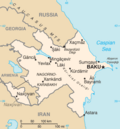History
In 1847, Azerbaijan became the site of the world's first industrially drilled oil well. [8] By 1899, Azerbaijan produced half of the volume of the world's oil. [8]
The Araz hydroelectric power station with a total capacity of 22 MW was constructed in 1970, Tartar hydroelectric power station with a total capacity of 50 MW in 1976 and Shamkir hydroelectric power station with a total capacity of 380 MW in 1982. [9]
At that time, along with the construction of power stations, electrical networks were systematically developed and the country's sustainable energy system was created. In those years, "Ali Bayramli" thermal power station with 330 kV – Aghdam – Ganja – Aghstafa, Ali Bayramli – Yashma – Derbent, 5th Mingachevir, 500kV 1st and 2nd Absheron, Mukhranis – Vali and other power lines, Yashma, Ganja, Agstafa with 330/110/10 kV, Imishli with 330/110/10 kV, Absheron with 500/330/220 kV, Hovsan, Nizami, Mushfig, Sangachal, Masalli, Agsu, and Babek with 220/110/10 electrical substations have been put into operation. [10]
A $53 million loan was granted to Azerbaijan by the European Bank for Reconstruction and Development for the construction of the Yenikend hydroelectric power station in December 1995, and the Yenikend HPP was built with a total capacity of 150 MW. [11]
The reconstruction of the Mingachevir hydroelectric power station, 330 kV Aghjabadi, 110 kV Barda substations and the 330kV Azerbaijan Thermal Power Station – 330 kV Agjabadi-Imishli transmission lines were implemented at the expense of the European Bank for Reconstruction and Development and the Islamic Development Bank. [12]
Two gas-turbine units with a capacity of 53.5 MW each at Baku thermal power station, funded by the German bank – Bayerische Landesbank Girozentrale, and a 400MW steam gas plant at the Shimal power plant at the expense of the Japanese International Cooperation Bank's loan were commissioned in 2002. [13]
On February 14, 2005, the head of state approved the State Program on Development of the Fuel and Energy Complex (2005–2015) in the Republic of Azerbaijan. [14]
The electricity demand of the economy of the country has been completely provided by 12 thermal power stations such as Azerbaijan TPP, Shirvan TPP, Shimal TPP, Baku TPP, Nakhchivan TPP, Astara, Khachmaz, Sheki, Nakhchivan, Baku, Quba, Sangachal power stations, and 6 water power stations such as Mingechevir, Shamkir, Yenikend, Varvara, Araz, and Vaykhir HPP. Their total capacity was about 5,900 megawatts. 90 percent of electricity production in Azerbaijan accounts for TPPs, and 10 percent for hydroelectric power stations. [10]
The Energy Regulatory Agency under the Ministry of Energy was established on the basis of the Department for State Energy And Gas Supervision of the Ministry of Energy of the Republic of Azerbaijan by the decree of the president dated December 22, 2017, and its charter was approved. [15]
According to the World Energy Trilemma İndex, compiled by the World Energy Council for 2017, Azerbaijan has taken 31st place (BBA) among 125 countries. [16]
According to the Global Energy Architecture Performance Index report for 2017, compiled by the World Economic Forum, Azerbaijan ranked 36th out of 127 countries with a 0.67 score. [17] According to the 2016 report from the same organization, Azerbaijan ranked 32nd out of 126 countries with a 0.68 score. Economic growth and development had a 0.68 score, environmental sustainability a 0.57 score, and energy access and security a 0.79 score. [18]
On April 19, 2019, SOCAR president Rovnag Abdullayev and BP’s regional president for Azerbaijan, Georgia, and Turkey, Garry Johns signed a contract for $6 billion. The final investment decision on the Azeri Central East (ACE) platform, which is planned to be built on the Azeri-Chirag-Gunashli (ACG) block, was adopted at the signing ceremony. Construction was scheduled to start in 2019, and the completion was scheduled for mid-2022. [19] [20] [21] [22]



